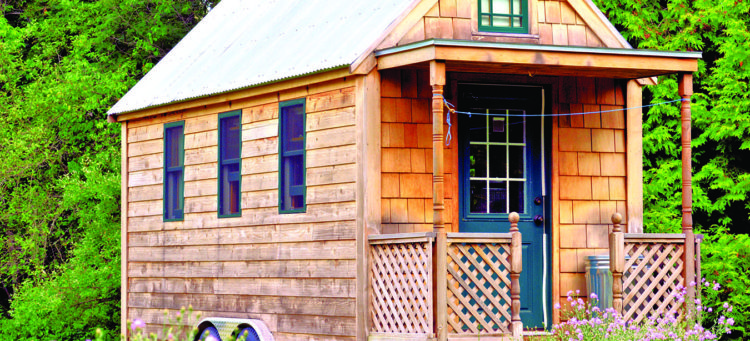
Trending
Tiny Houses: Livin’ Large in Tiny Spaces - Make room for the tiny-house movement
By Robert Michon
March, 2017
For a long time, living in a big house was a marker of success. But these days, more and more people are going out of their way to live in extremely small spaces. The tiny-home movement, as it’s known, has been picking up speed, and in the last few years has made its way to Alberta. For some, the concept of delighting in having less is a bit hard to fathom. But those who live tiny know that smaller homes have a lot to offer. And what is lost in square footage is gained in lifestyle. Think you might be interested? Here’s a look at the tiny-house movement.
What Is a Tiny Home?
There is no concise definition for the term tiny home, as they can be many different things to many different people. But there is one trait that all tiny homes have in common: they are small—usually around 400 square feet. Beyond this one attribute, they can be almost anything. Some tiny homes are on wheels, some are on water, some resemble traditional houses, some are one-room apartments and many make use of existing spaces such as shipping containers and school buses—fully renovated, of course.
According to Kerri Timbers of YEG Tiny Homes, the beauty of the tiny-home movement is its diversity.
“It’s a movement that is defined by variation. What your tiny home looks like depends entirely on you.”
As you might expect, the movement is very closely associated with the concept of minimalism. But just like minimalism, tiny living can mean different things to different people. As Kerri explains,
“Tiny homes reflect what their owners value. You learn what you need and what you could live without. Then, you design your house based on what works
best for you.”
What Is the Appeal?
Tiny-home enthusiasts are attracted to the lifestyle for many different reasons, but the big draw for many people is the financial aspect. Buying a home can cost a lot of money, and for a growing portion of the population, the years of work necessary to afford one’s own space just isn’t worth it. By living tiny, you can become a property owner without the 25-year mortgage.
Another large contingent of the movement is made up by the sustainability crowd. A tiny home has less of an impact on the environment because it takes fewer resources to build and less energy to power. Many tiny-home owners even choose to exist off the grid and generate their own power with solar and wind generators.
The other major demographic fuelling the tiny-home movement is the adventurer. When it comes to tiny homes on wheels, mobility is its own reward. Those who live in converted vehicles or in custom-built mobile homes can pick up and travel whenever they want—and they don’t have to leave anything behind. This has proven an attractive prospect for travellers both young and old.
Who Can Live Tiny?
For many of us, it can be hard to imagine living comfortably in a tiny home—especially if you have a big family. But according to Kerri, tiny-home enthusiasts are a diverse bunch.
“The movement attracts everyone from university-aged kids to retirees. In our YEG Tiny Home community, we’ve got single folks, married couples and even a family of four.”
Many seniors find themselves drawn to the movement after their children have grown and moved out, leaving them with more living space than they either need or want to maintain. Some are even opting to build their own tiny homes and to rent their full-sized homes as income properties.
But tiny living isn’t just for couples or singles. Families around the world are choosing to live tiny together. According to Kerri, that can build stronger families.
“When you’re living in close quarters with so many other people, you have to learn to live and function together. You can’t just go off to your separate corners of the house and ignore each other. This can be great for raising kids. It brings families closer together by necessity.”
Challenges of Living Tiny
Living tiny can take a lot of work. This is especially true for tiny homes that exist off the grid. To do so, you’ve got to secure your own water and your own energy; in Kerri’s experience, it’s essential to be aware of how much of those resources you consume. “If propane is your primary source of heat, you’ll want to be sure that you’ve done your measurements and that you know how long each tank will last you,” says Kerri. “You don’t want to wake up to find your supply is empty in the middle of winter.”
Legality
Strictly speaking, tiny homes aren’t exactly legal in the capital region. It’s not that they’re illegal, it’s just that no laws have been made for them yet. There are, of course, established building codes for houses, and there are laws around manufacturing specifications for things such as RVs, but tiny homes exist in a legal grey area somewhere in between. That, however, doesn’t stop many people from building their tiny dream homes.
“You can build tiny homes here in Alberta,” says Kerri,
“And many people do. But there are no laws to guide you. If you want to build one, you’ll have to have a conversation with the city to get permission. If you don’t, you’re putting yourself at risk of getting evicted or shut out of your own home because it’s not up to code. The problem, of course, is that no such code exists.”
Building Your Own Tiny Home
Despite the newness of the movement, many groups and organizations already exist to teach people how to start living tiny. Kerri’s organization, YEG Tiny Home, hosts regular meet-ups and presentations where tiny-home enthusiasts share their experiences and teach others what they’ve learned. Organizations such as the Edmonton Permaculture Guild and KZ Permaculture both offer tiny-home workshops where you can get hands-on experience and practical advice on planning and building your tiny home. Thanks to this community and its vision for livin’ large, it’s never been easier to go tiny. t8n
Fun Fact
While the tiny-home movement seems new and trendy here in North America, people in densely populated areas in Europe and Asia have been living tiny for hundreds of years. Tiny-home culture is especially popular in Japan, where the population density is over 300 times higher than it is here in Canada.
Did You Know?
The tiny-home movement exists nationwide. Tiny Home Alliance Canada, a national directory of tiny-home resources, lists more than 100 tiny-home-related businesses and organizations across the country.













